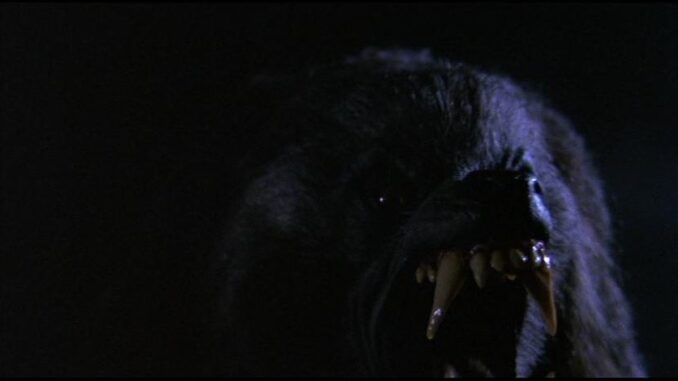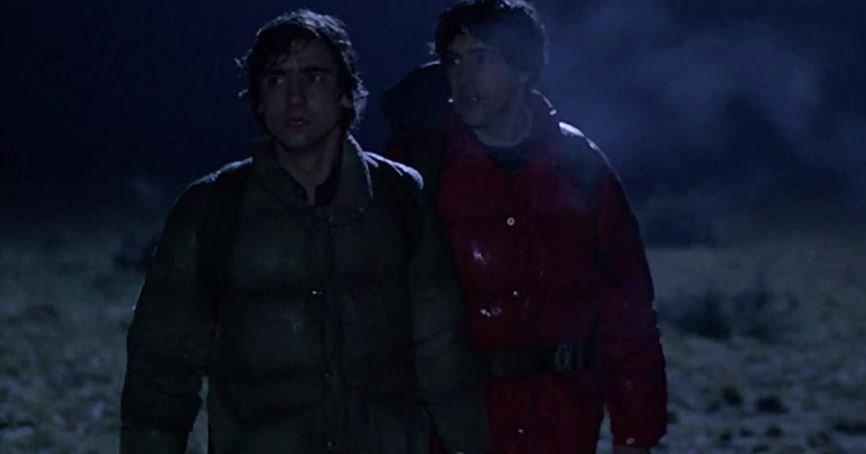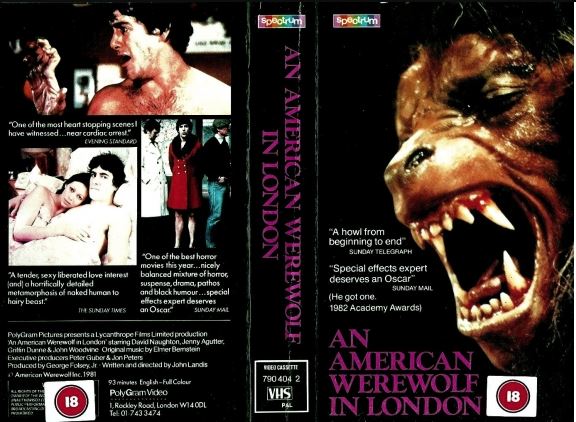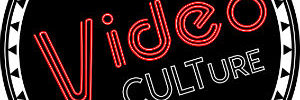
“Staff Picks” is a deeper look into movies that we love here at Video CULTure. Each edition of this column will focus on a single film that we think you should check out, either for the first time or for a long-overdue revisit.
By Patrick Bartlett (Twitter: @alleywaykrew)
Just like in 1987 when two of the greatest vampire movies in the history of cinema, “Near Dark” & “The Lost Boys” came out within months of each other, in 1981, arguably the two greatest werewolf movies ever were released. I will likely get to “The Howling” at some point but first, I wanted to talk about the most famous werewolf film not called “The Wolf Man” and that is “An American Werewolf in London”. This is a film that really should not exist. It was a movie that John Landis had tried to make for years before it finally made it into production and was released in 1981. Landis was repeatedly told that it was too scary to be funny and too funny to be scary (which is paradoxical). It’s neither. Horror comedies are always a dodgy prospect because honestly… the people that made that argument to Landis weren’t necessarily wrong. It’s extremely difficult to do them in such a way that they’re particularly scary or funny. At this point in cinematic history, there wasn’t even really an example to point to. This film is ostensibly the prototype, which is part of what makes it special.

For anyone who may have not seen this masterpiece, the film is about a young American man named David Kessler. He’s backpacking through Europe with his friend and fellow American, Jack. While in England, they end up at a pub called the Slaughtered Lamb where they are not made in almost any way to be welcome. When they finally leave the pub, they’re warned to keep to the road and stay away from the moors. It begins to rain soon after. The two end up accidentally violating that warning and Jack is ripped apart by what appears to be a large wolf on the moors. David is merely scratched before the denizens of the Slaughtered Lamb kill the “wolf”, only to have David see him turn back into a man before losing consciousness. When he wakes up, he’s in a hospital in London. I guess I should note that this is a world where movies like “The Wolf Man” exist as works of fiction, so no one believes David’s story about a giant wolf attack. Right before he’s released from the hospital, he encounters Jack, this time as a grisly spectre. Jack lets him know that David is now a werewolf himself and until he’s dead and the wolf’s bloodline is severed, Jack and any other victims will be doomed to walk the Earth in a ghostly state on a supernatural plane. David believes he’s starting to go as crazy as everyone thinks he is but when he’s released from the hospital, he’s taken in by his nurse, a woman named Alex. They spend a few days in domestic bliss before the full moon rises and despite how crazy it may seem, David transforms into a werewolf.
I’m going to stop here to discuss what this film is probably most famous for: the werewolf transformation scene. John Landis wanted to show a werewolf transformation that happened in-camera as much as possible. He also wanted it to be in full light. If you know anything about filmmaking, especially at this point in time, you know that this is a technical nightmare. Effects artist Rick Baker made himself immortal by rising to Landis’ challenge. To this day, I’m astonished every time I watch it. I know how they did the effects. I’ve seen so many videos and pictures from the set. I can see the proverbial seams. Yet, I’m still gobsmacked every time. With good reason. Many have tried in the almost four decades since but even to this day, no one has been able to come close to what is on display here. It’s not only beautiful to look at but also accomplished something that I had never really thought about up to that point (and I watched “The Wolf Man” a lot as a kid) but the idea that the transformation is something horrific and painful is as devastating to watch as it is completely logical. The idea of your body changing into something completely different is probably going to be an awful experience and we’re shown David’s body breaking apart as it reforms in real-time and you can’t help but sympathize with him, even knowing what’s going to happen once he’s transformed, which credit is due as much to Landis as it is to Baker.

When David transforms, he cuts a bloody swath through London. It seems like if you’re out and about and you’re within a reasonable radius of Alex’s flat, you’re going to get ripped to shreds. Probably my favorite sequence in the film, even more so than the transformation takes place in the London Underground. A man’s just gotten off the train and is chased through the tube station by what appears to be a giant demonic wolf. It’s almost all shown from the wolf’s perspective. You don’t actually see the werewolf until right before it does what werewolves generally do and it’s legitimately scary, even having seen this film countless times. David’s visited by Jack again and again, continuously being urged to kill himself lest he create even more spirits stuck in limbo due to the supernatural nature of their deaths. David at one point even tries to kill himself before he can murder again but simply can’t bring himself to do it. He tries to get himself arrested but the officer doesn’t take him seriously. It feels hopeless for the character because it more or less is. It all ends with a grand finale of David as a werewolf tearing up Picadilly Circus that really has to be witnessed to be believed. I don’t want to spoil it for anyone who hasn’t seen it but werewolves are probably the most tragic of the classic monsters and this movie’s ending doesn’t stray far from that path.

In retrospect, I can completely see why it would be so hard for John Landis to get this film made. On paper, it’s a legitimately funny film, not terribly far off from things that Landis had become known for at that point like “Animal House” & ‘The Blues Brothers.” In the midst of the funny scenes, there are legitimately horrifying moments that aren’t funny in the slightest. If you didn’t have something like this or “The Howling”, which was being created at basically the same time, I don’t know how you convince someone of what the end product would be. The reason it works is because Landis never goes as fully over the top with humorous situations as he did in something like “The Blues Brothers.” Even when the film is funny, it’s generally coming from the performances and sometimes from the absurdity of the situation but there isn’t any kind of grand comic set piece like there was in Landis’ previous work. All the set pieces in the film are the horror scenes. It’s basically as if the non-werewolf scenes were the setup and the horror ends up being grisly punchline. There’s a lot of negative things that you can say about John Landis as a man and even as a filmmaker but his mastery of tone here really can’t be overstated.
The other major reason the film works as well as it does is the cast. David Naughton plays the character of David as a guy with a great sense of humor in a maddeningly horrific situation and as such, ends up being incredibly endearing. You’re never not on his side, despite what his carnivorous alter ego does during the nights of the full moon. Griffin Dunne’s take on Jack is very similar. It’s completely understandable why the two would be friends. He’s funny even in varying states of decay. Jenny Agutter brings a quality to Alex where she’s clearly falling in love with him almost from the beginning, accepting him even with what seems like delusions. She at one point tells him that she’s torn between feeling very sorry for him and finding him terribly attractive. It makes total sense why she would be intrigued by him. It’s her strength in never wavering from wanting to be with him and to help him, regardless of what he may or may not be doing, that’s intriguing to me. It’s why I can buy into their tragic love story without question.

Werewolf cinema is probably my favorite horror subgenre. A lot of werewolf movies are some of my very favorite movies. More than anything else similar, there’s generally a consistency that you don’t necessarily find in genre filmmaking. What I’m more or less trying to say is that werewolf movies are generally good more often than not. Having said that, “An American Werewolf in London” stands head and shoulders above the rest as far as I’m concerned. The purity and simplicity of the story and how well it’s told are why this film still feels fresh decades after its release while many films of the same period just don’t. It’s immortal. You can’t talk about werewolves in film without this being one of the first examples that’s brought up and there’s a reason. It’s a truly great film. I’m not saying it’s just a great genre film. It’s a great film. It’s not too scary to be funny or too funny to be scary. It’s right smack dab in the middle and one of the most purely entertaining films ever made, in addition to being a technical marvel. I can’t recommend it enough.

To find out where this film is available to stream, click here: Just Watch
